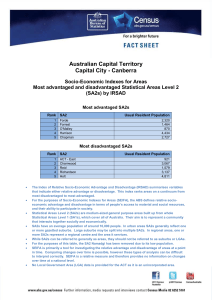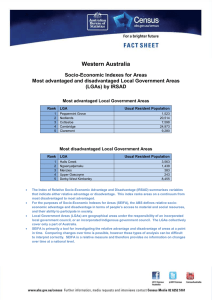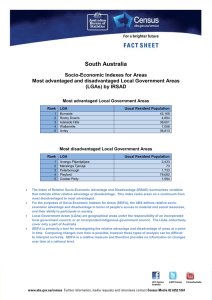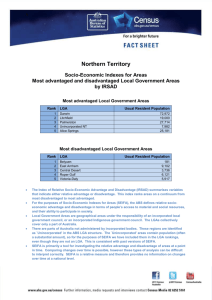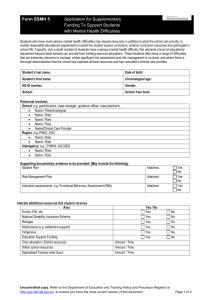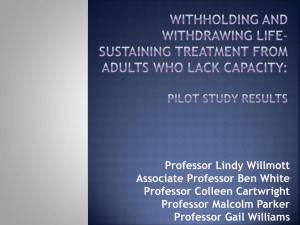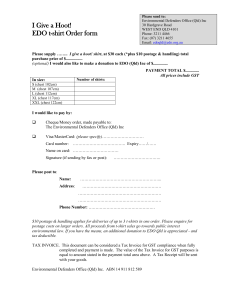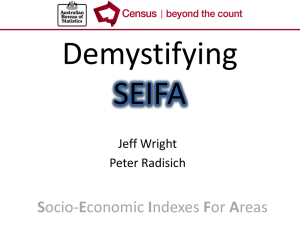Australia
advertisement
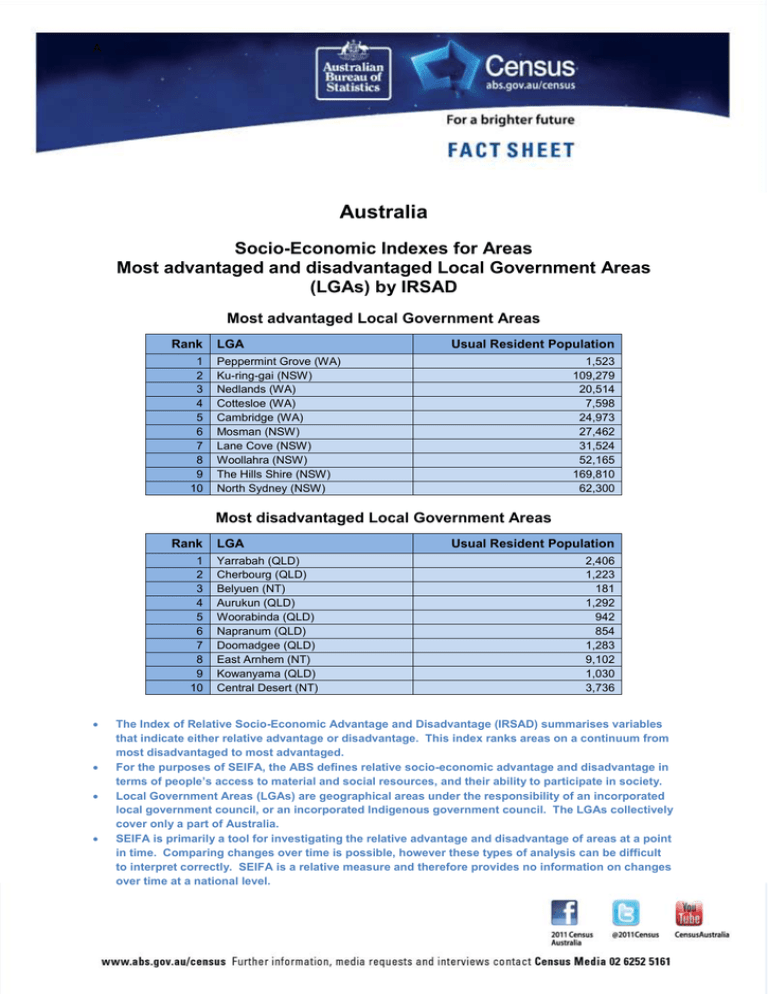
A Australia Socio-Economic Indexes for Areas Most advantaged and disadvantaged Local Government Areas (LGAs) by IRSAD Most advantaged Local Government Areas Rank 1 2 3 4 5 6 7 8 9 10 LGA Usual Resident Population Peppermint Grove (WA) Ku-ring-gai (NSW) Nedlands (WA) Cottesloe (WA) Cambridge (WA) Mosman (NSW) Lane Cove (NSW) Woollahra (NSW) The Hills Shire (NSW) North Sydney (NSW) 1,523 109,279 20,514 7,598 24,973 27,462 31,524 52,165 169,810 62,300 Most disadvantaged Local Government Areas Rank 1 2 3 4 5 6 7 8 9 10 LGA Yarrabah (QLD) Cherbourg (QLD) Belyuen (NT) Aurukun (QLD) Woorabinda (QLD) Napranum (QLD) Doomadgee (QLD) East Arnhem (NT) Kowanyama (QLD) Central Desert (NT) Usual Resident Population 2,406 1,223 181 1,292 942 854 1,283 9,102 1,030 3,736 The Index of Relative Socio-Economic Advantage and Disadvantage (IRSAD) summarises variables that indicate either relative advantage or disadvantage. This index ranks areas on a continuum from most disadvantaged to most advantaged. For the purposes of SEIFA, the ABS defines relative socio-economic advantage and disadvantage in terms of people’s access to material and social resources, and their ability to participate in society. Local Government Areas (LGAs) are geographical areas under the responsibility of an incorporated local government council, or an incorporated Indigenous government council. The LGAs collectively cover only a part of Australia. SEIFA is primarily a tool for investigating the relative advantage and disadvantage of areas at a point in time. Comparing changes over time is possible, however these types of analysis can be difficult to interpret correctly. SEIFA is a relative measure and therefore provides no information on changes over time at a national level. A Australia Socio-Economic Indexes for Areas Most advantaged and disadvantaged Statistical Areas Level 2 (SA2s) by IRSAD Most advantaged SA2s Rank 1 2 3 4 5 6 7 8 9 10 SA2 Usual Resident Population North Coogee (WA) Forde (ACT) Forrest (ACT) O’Malley (ACT) Harrison (ACT) Iluka-Burns Beach (WA) Pinjarra Hills-Pullenvale (QLD) St Ives (NSW) City Beach (WA) Fig Tree Pocket (QLD) 582 2,320 1,464 870 4,434 6,170 5,360 18,635 6,355 3,651 Most disadvantaged SA2s Rank 1 2 3 4 5 6 7 8 9 10 SA2 Yarrabah (QLD) Aurukun (QLD) Thamarrurr (NT) East Arnhem (NT) Yuendumu-Anmatjere (NT) Sandover-Plenty (NT) West Arnhem (NT) Gulf (NT) Palm Island (QLD) Tanami (NT) Usual Resident Population 2,406 1,292 2,301 7,510 2,070 3,744 4,708 4,047 2,339 2,942 The Index of Relative Socio-Economic Advantage and Disadvantage (IRSAD) summarises variables that indicate either relative advantage or disadvantage. This index ranks areas on a continuum from most disadvantaged to most advantaged. For the purposes of SEIFA, the ABS defines relative socio-economic advantage and disadvantage in terms of people’s access to material and social resources, and their ability to participate in society. Statistical Areas Level 2 (SA2s) are medium-sized general purpose areas built up from whole Statistical Areas Level 1 (SA1s), which cover all of Australia. Their aim is to represent a community that interacts together socially and economically. A SA2s have an average population of around 10,000 people. In urban areas SA2s generally reflect one or more gazetted suburbs. Large suburbs may be split into multiple SA2s. In regional areas, one or more SA2s represent a regional centre and the area it services. While SA2s can be referred to generally as areas, they should not be referred to as suburbs or LGAs. SEIFA is primarily a tool for investigating the relative advantage and disadvantage of areas at a point in time. Comparing changes over time is possible, however these types of analysis can be difficult to interpret correctly. SEIFA is a relative measure and therefore provides no information on changes over time at a national level.
